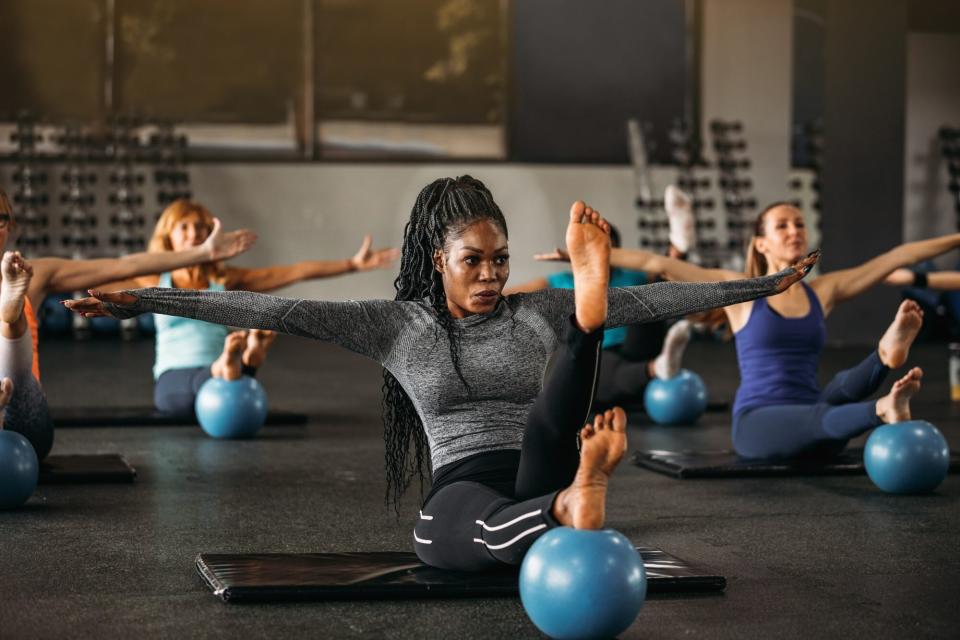Everything You Need to Know About Pilates
- Oops!Something went wrong.Please try again later.
It seems as if there is a new workout routine or fitness subscription every day, but one tried-and-true ways to strengthen your body has been around for a century—and it's not going out of style any time soon. Pilates is a form of low-impact exercise that has been shown to increase flexibility, tone muscles, and improve joint health. Jacqui Kingswell, Pilates instructor and co-founder of The Pilates Class, says that this type of workout "creates a balanced body with strength and flexibility, meaning you are less likely to experience injuries." And the benefits of regular practice don't stop there.
Related: Why You Should Add Vinyasa Yoga to Your Exercise Routine
What Is Pilates?
Pilates is a type of exercise that focuses on improving flexibility, strength, and body awareness through controlled movements and was created in the 1920s by German physical trainer Joseph Pilates for rehabilitation purposes. His method was influenced by other forms of exercise, including gymnastics and boxing. According to Kingswell, dancers and soldiers returning from war were among the first people to benefit from this practice.
Pilates movements tend to focus on core activation through sets like toe taps, leg extensions, and abdominal curls. Kingswell notes that you will see these movements worked into every session. "During the class, you might experience a nice burn in targeted areas, but afterwards you can expect to feel really lengthened, energized, and open," she adds. Classes can be performed without equipment using just your bodyweight, but you can add in weights and resistance bands once you have a stronger foundation.

vgajic / Getty Images
Who Is Pilates For?
Pilates caters to everyone, no matter their age or fitness level. Kingswell has people of all ages in her classes, including members that are 70 or older. "It's a practice that is sustainable and can be done consistently for the rest of your life," she says. Unlike high intensity workouts (think interval training), the low impact nature of Pilates makes it a safe option for everyone To gain the maximum benefit, Kingswell recommends beginners take two to three Pilates classes per week, combined with a 30-minute walk. For more of challenge, she says to ramp up sessions to four or five per week.
How Is Pilates Different Than Yoga?
Some aspects of Pilates are similar to yoga, but there are a few notable differences. Although both workouts focus on mindfulness, the latter places more of an emphasis on meditation and relaxation, while the former prioritizes actual exercises that get the core working. Movement is also a key difference. In yoga, you hold specific poses for an extended period; the poses typically repeat. Pilates features shorter sets with fewer repetitions.
However, there are some similarities between the two practices. Both Pilates and yoga use movements that strengthen the core and improve strength, balance, flexibility, and posture. Another tenet they share? The mind-body connection—both formats increase awareness of the body and breath to keep you strong and centered. "Breath is so important in Pilates classes, as it is the foundation of the core and one's fluidity in movement," Kingswell notes. "The controlled breathing activates the core and then the movement begins. In doing this, you get so much more out of the workout and a deeper connection with your body."
What Are the Health Benefits of Pilates?
The emphases Pilates places on core strength has several documented health benefits. Abdominal muscles are the front anchor of your spine; if they're weak, your back will rely on other parts of the body for stability, which can cause pain and make you more susceptible to injury. Beyond benefiting your back and posture, this fitness type boosts mobility, too. Its exercises and stretches elongate and strengthen your muscles. "Pilates is amazing for toning your muscles and sculpting," Kingswell says. "Your posture and body alignment also improves immensely as you become strong, flexible, and open."

